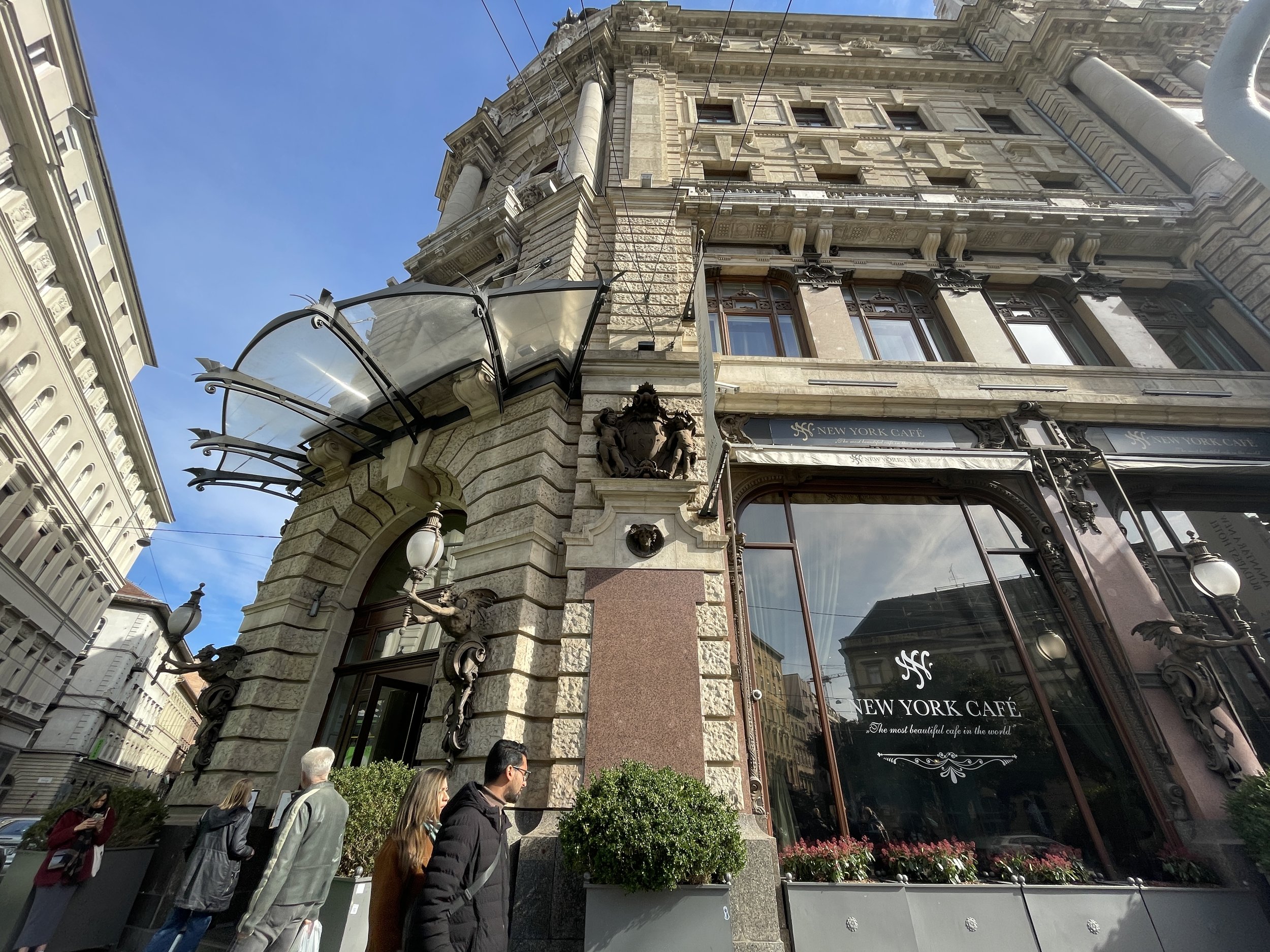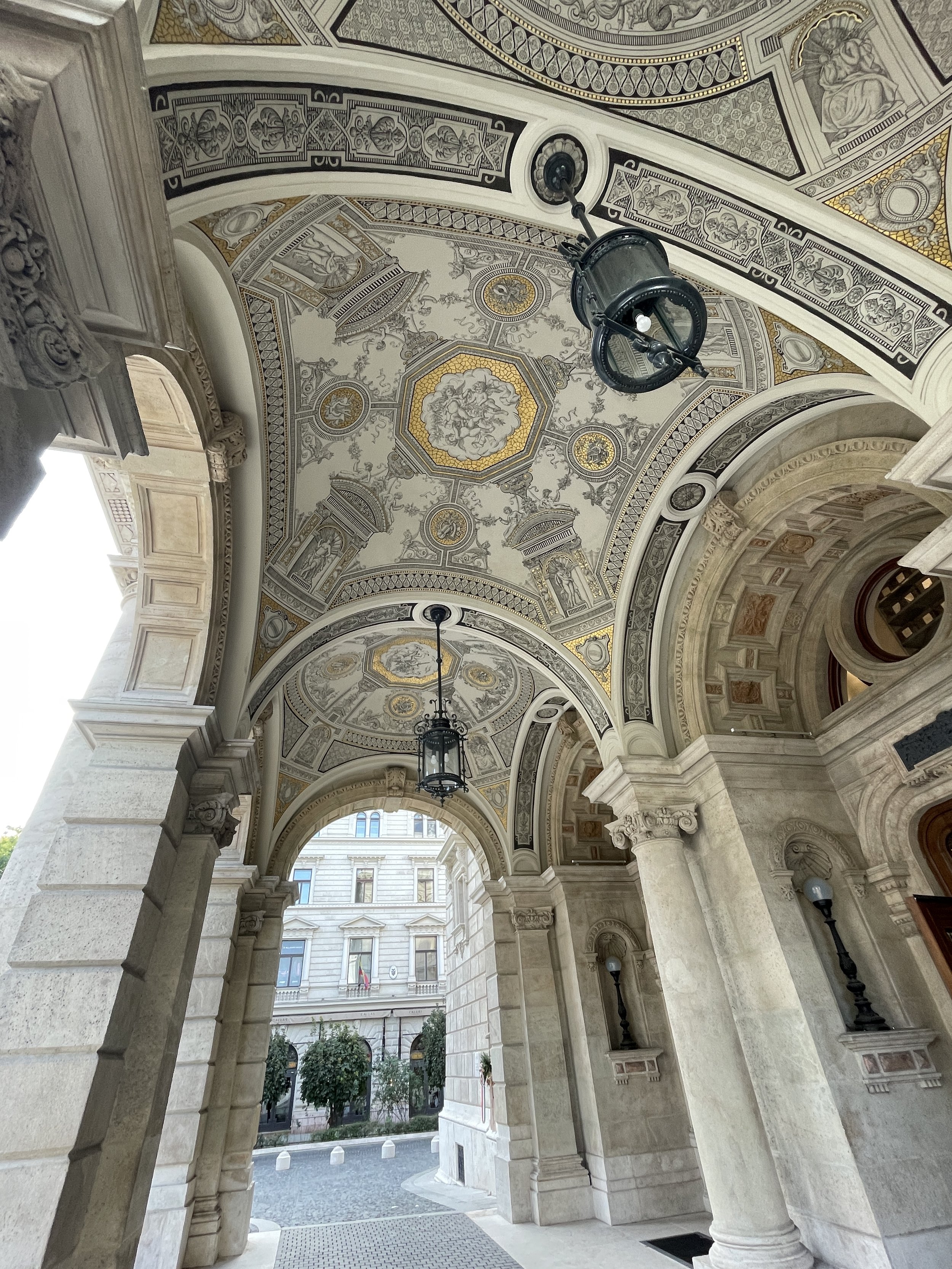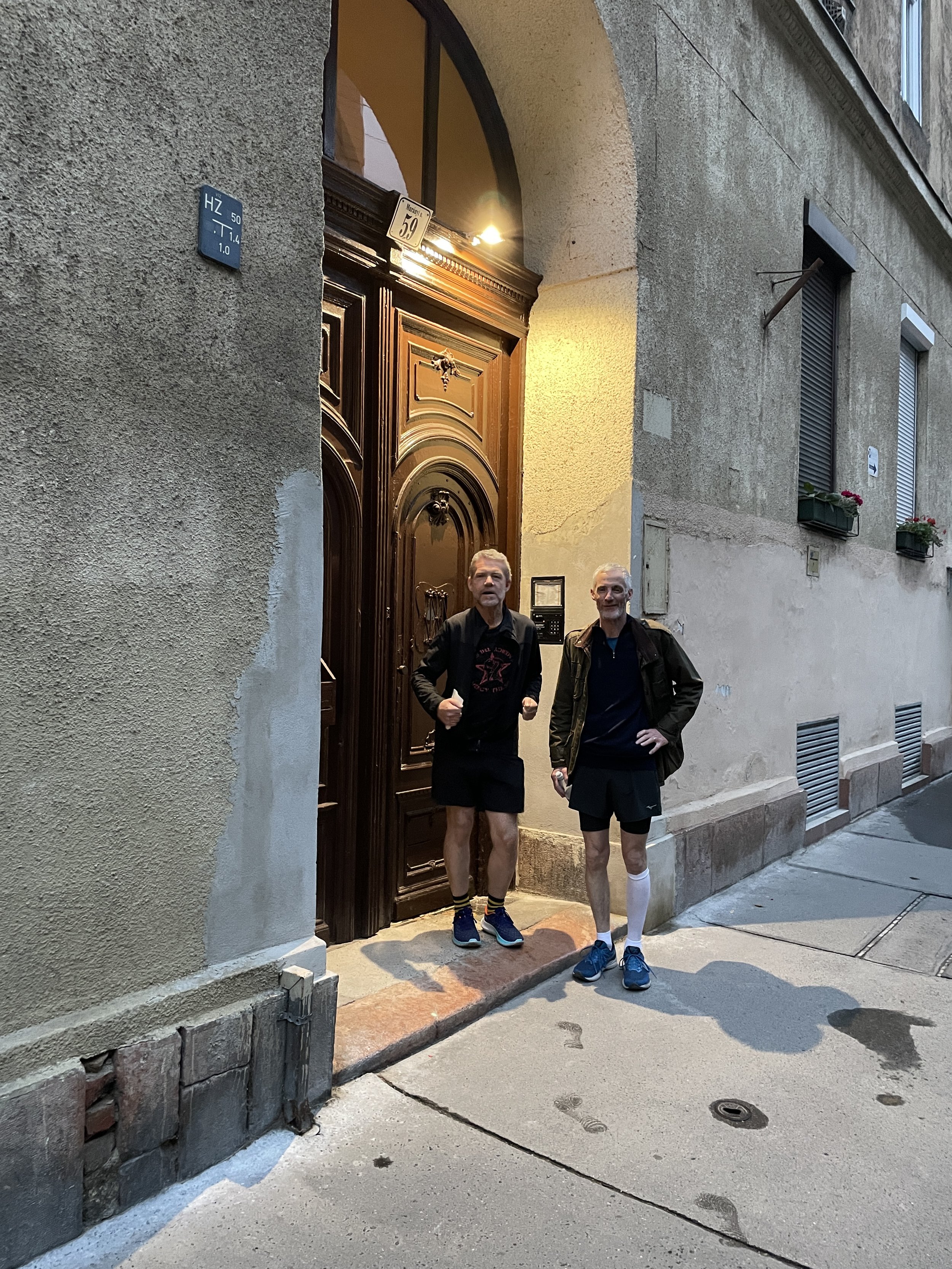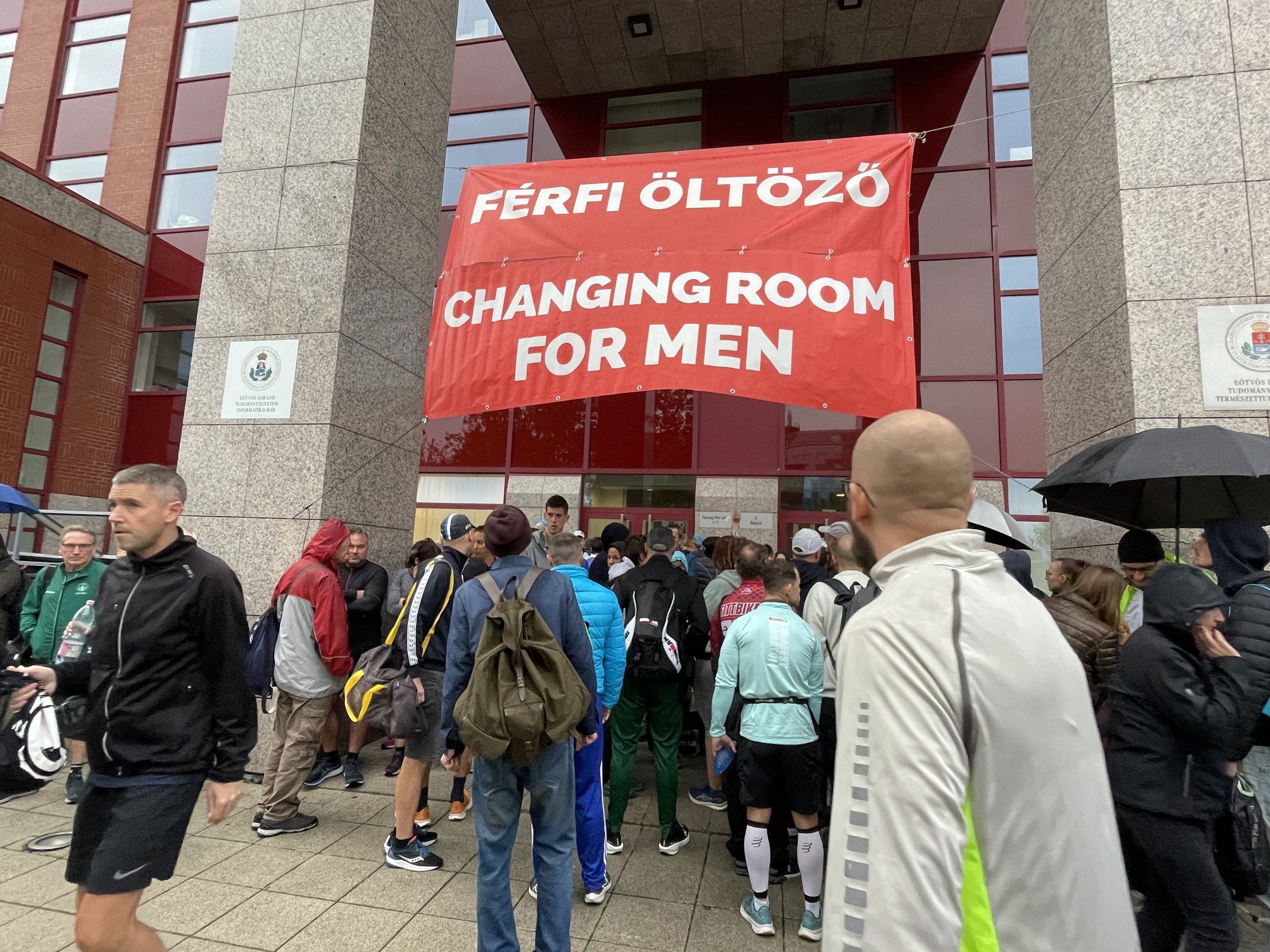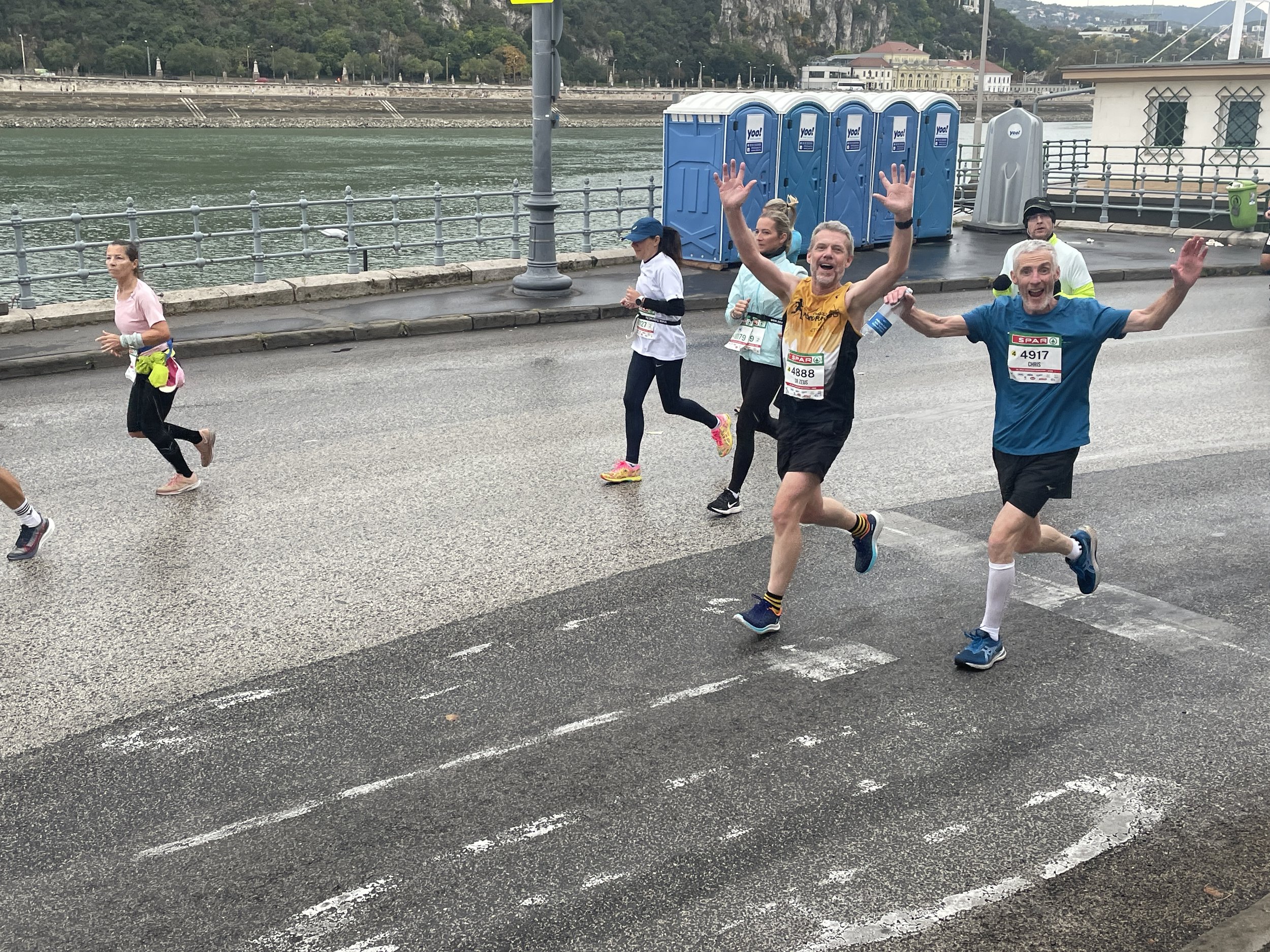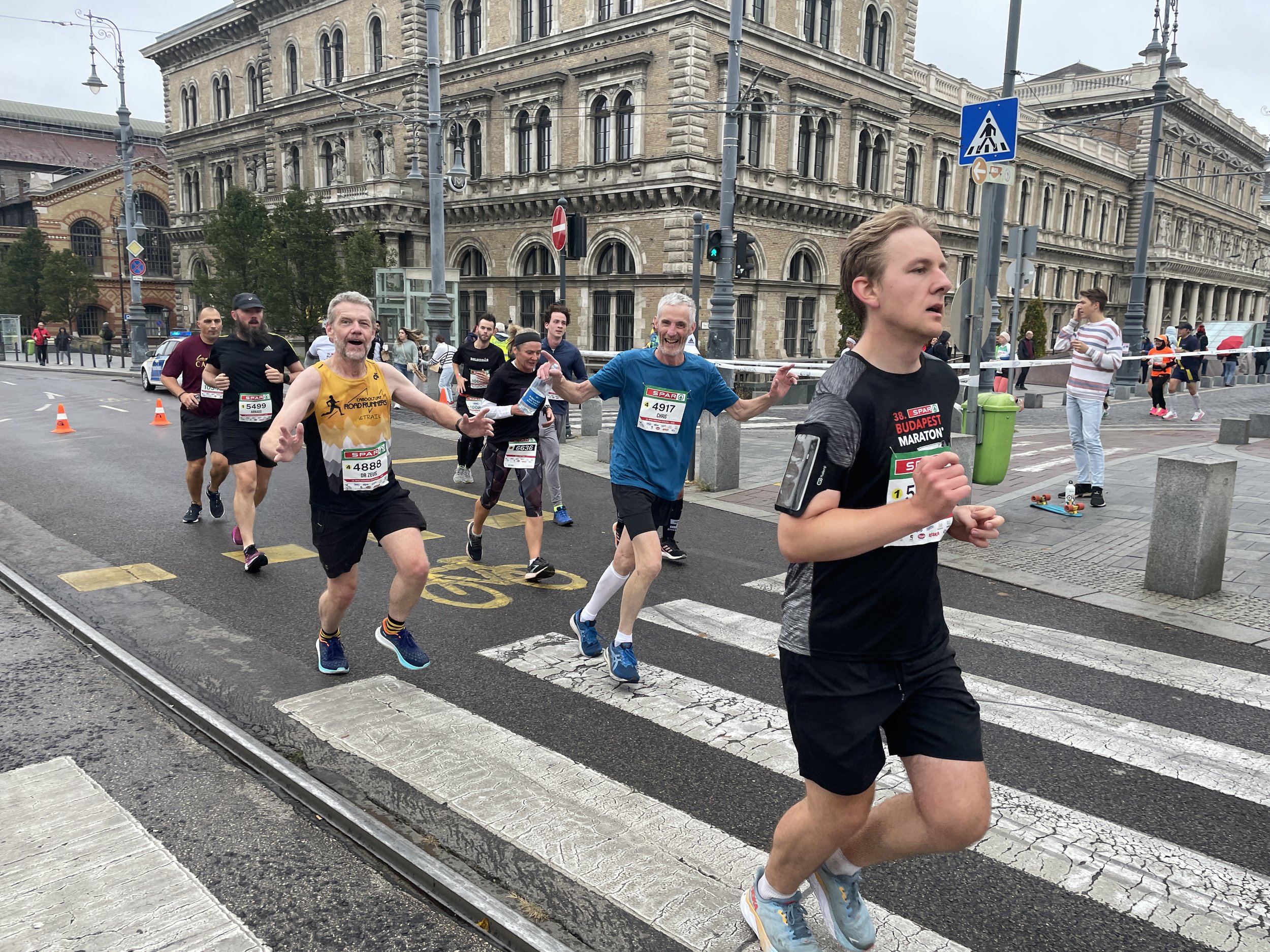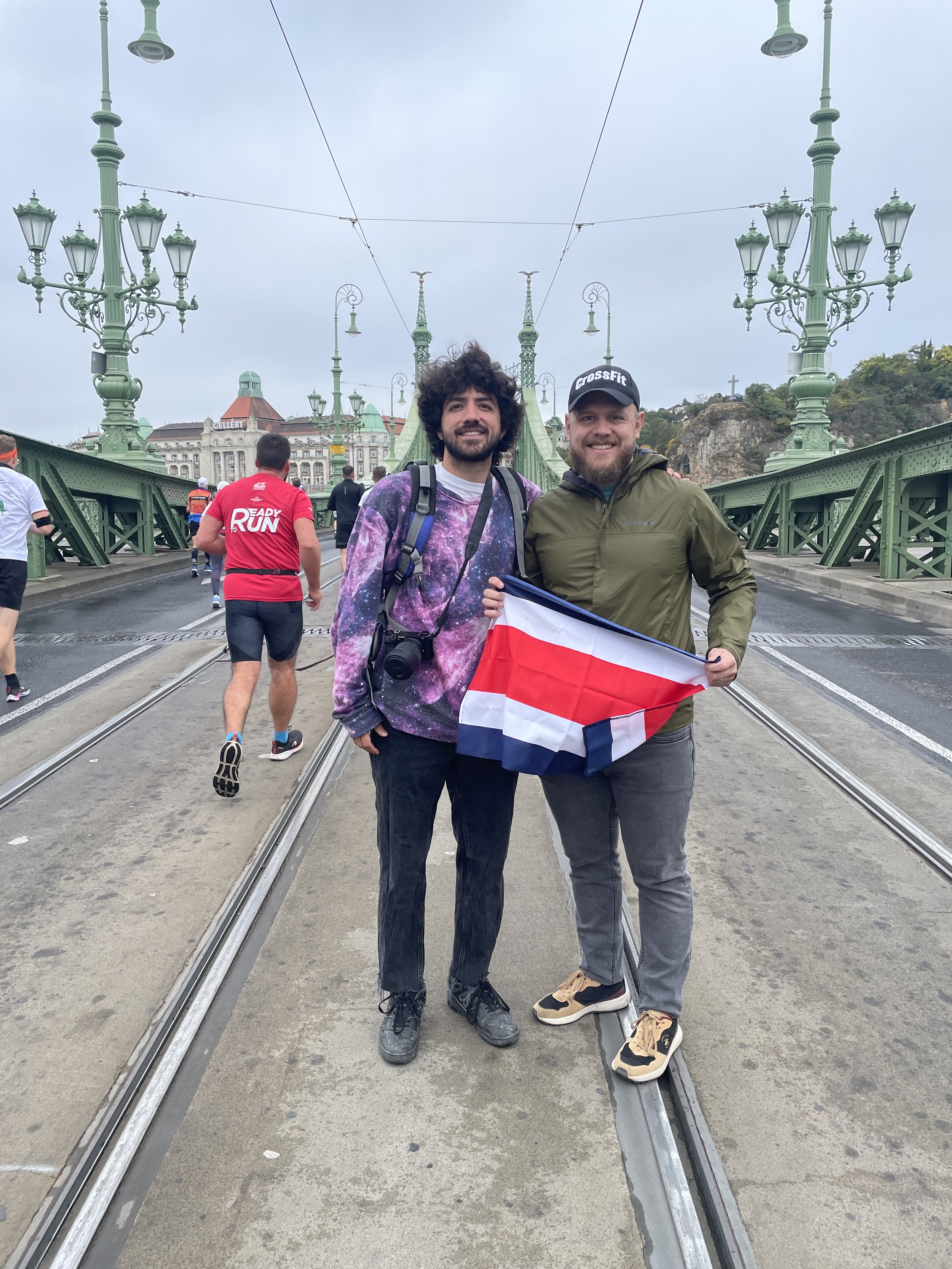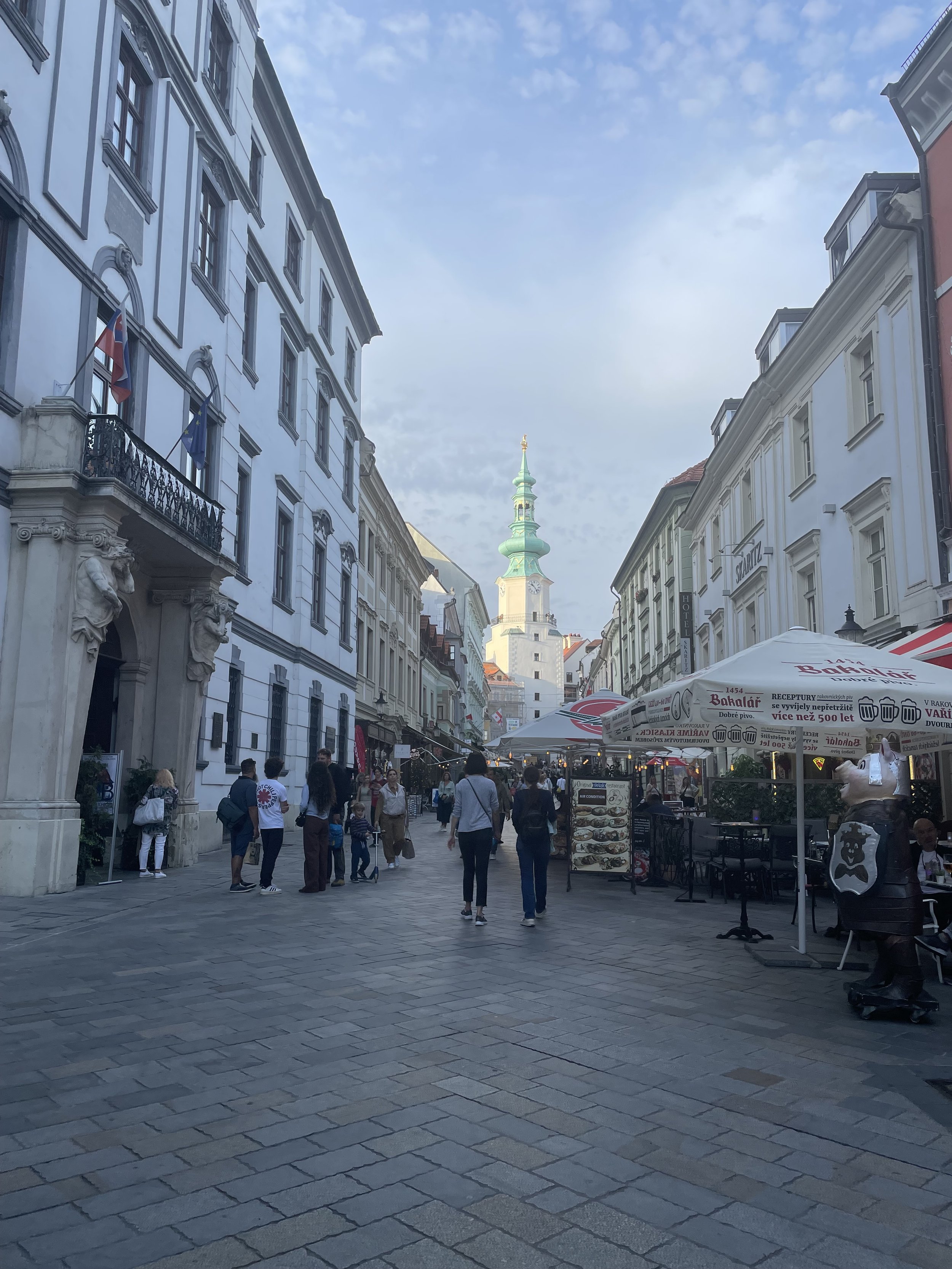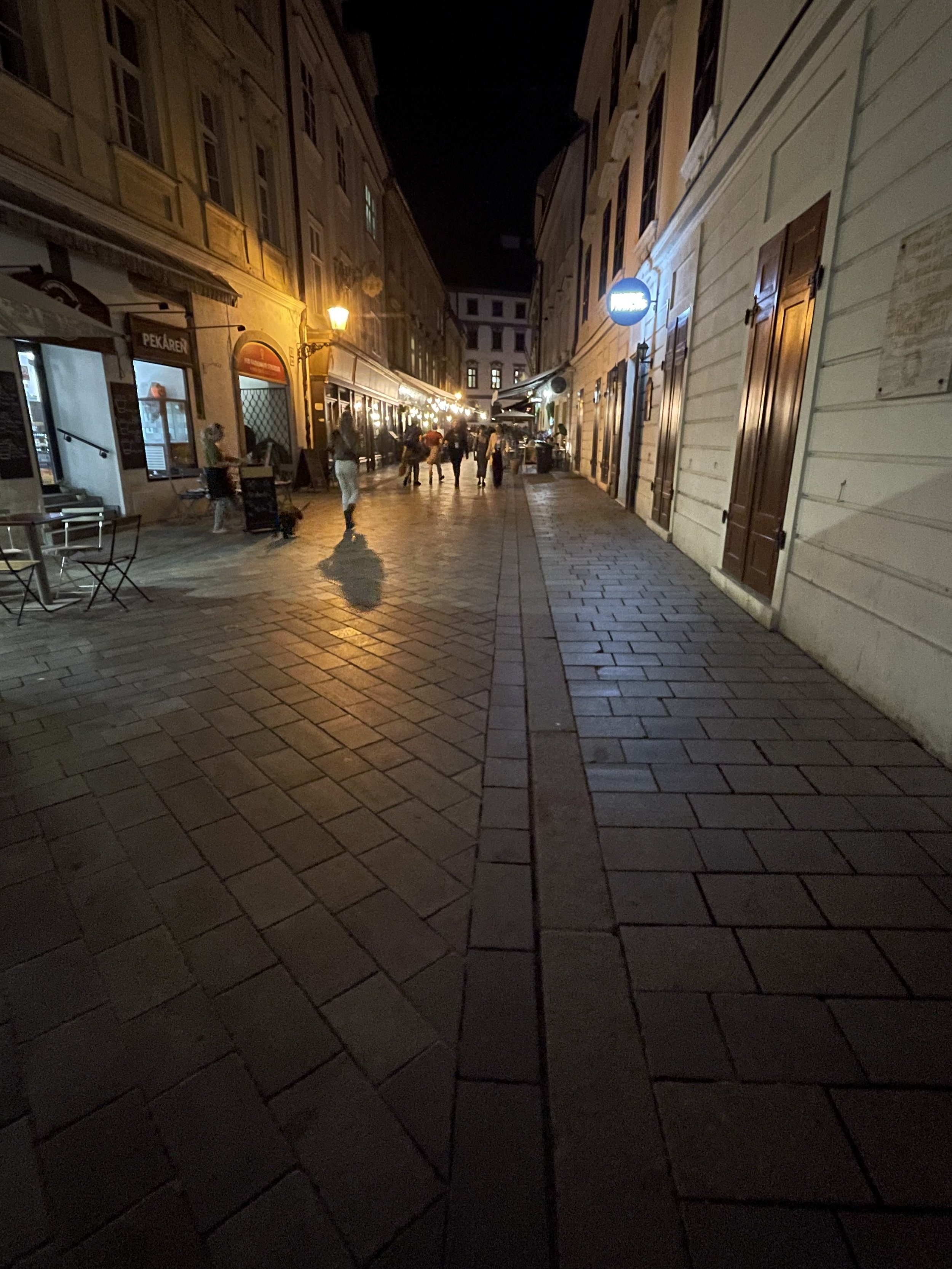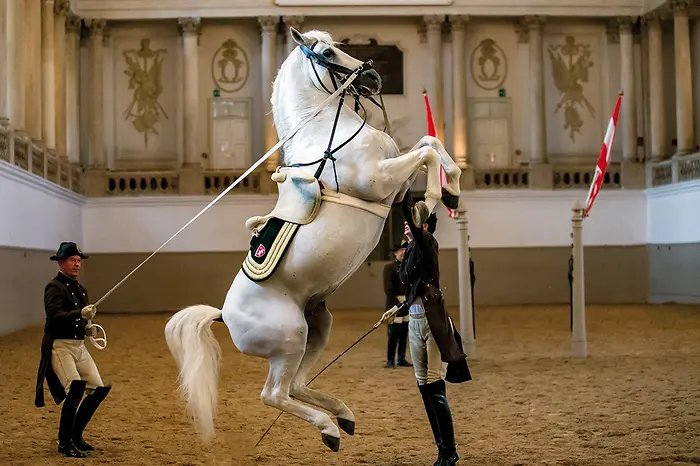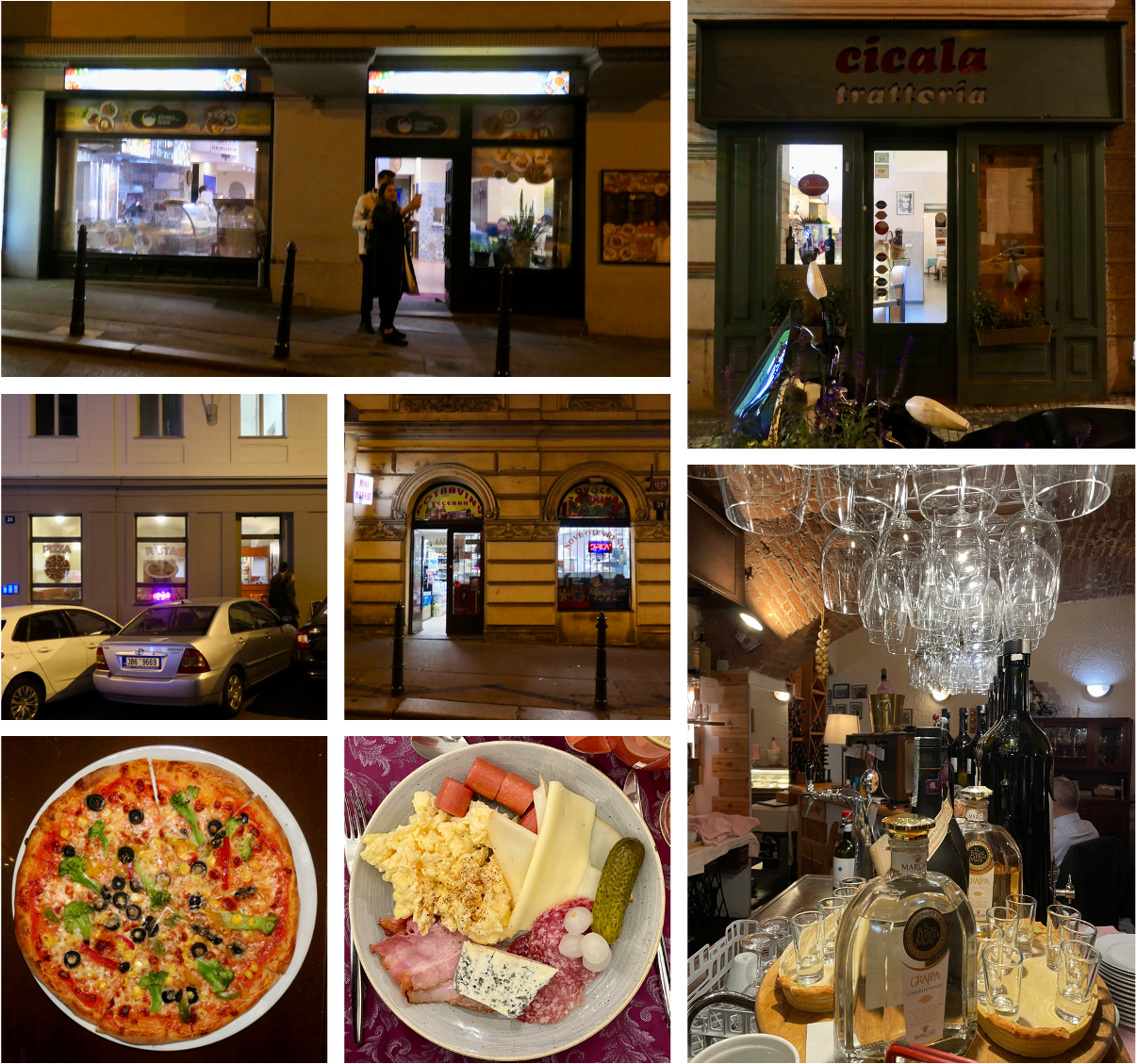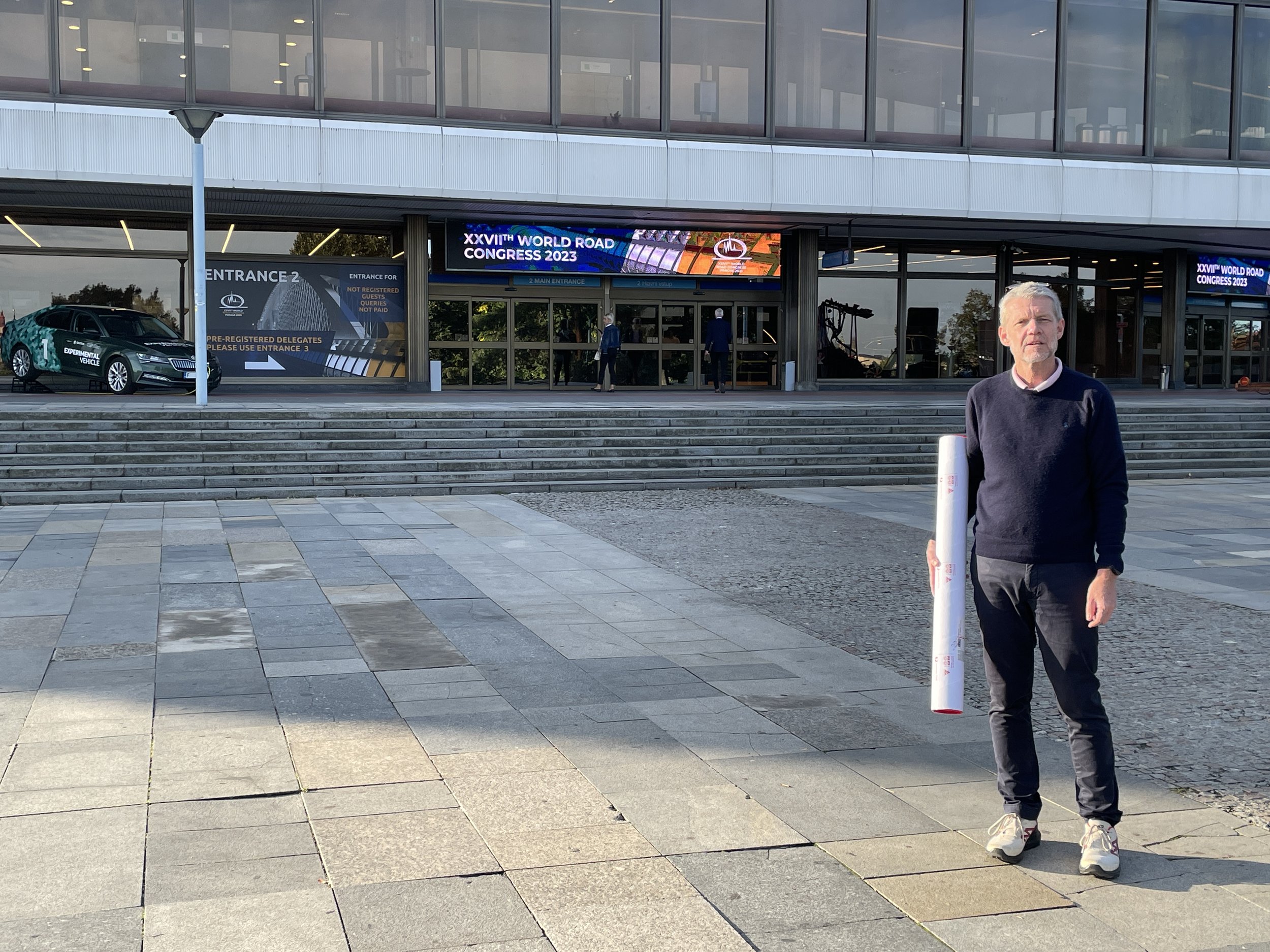Pest
Today we are exploring Pest, Hungary's capital city Budapest was formed from the merging of two separate cities, Buda and Pest, which were located on opposite sides of the Danube River. Buda was located on the west bank of the river, while Pest was on the east bank.
Again we take the metro train into Oktogon metro station, we make our way to the New York Cafe located on Erzsébet körút in the Anantara New York Palace Budapest Hotel. It is touted as the most beautiful cafe in the world - I don’t know if that is true but it certainly is the most beautiful cafe I have ever been to. Andy and I walked in - surprisingly there was no queue - when we went past on the tram on Sunday there was a queue down the road.
We were shown to a lovely little table tucked away and ordered cake and coffee. Music was being played and it was only after it stopped for a break did we realise there was a grand piano set up in the far corner of the cafe. The music started up again this time we had the piano and a violin playing.
The cakes we ordered were delicious, the coffees excellent and the atmosphere and interior fantastic. The bill was pretty amazing too - but how often do you have a coffee in a cafe with marbled columns, ceiling frescoes and crystal chandeliers.
Our next stop was a trip to the House of Terror - a museum located at Andrássy út 60. It contains exhibits related to the fascist and communist regimes in 20th-century Hungary and is also a memorial to the victims of these regimes, including those detained, interrogated, tortured or killed in the building.
Our visit to this museum was informative and interesting the excellent displays and layout are not just informative but atmospheric, especially the displays with interviews with survivors of the regimes giving first accounts of their experiences.
After our couple of hours in the museum we make our way to the Danube along Andrassy we walk past the Hungarian State Opera House and in a city of glorious, amazing buildings - this one stands out and we can’t help ourselves and make our way inside and are blown away. Note I am running out of adjectives to describe the beautiful architecture I have seen on this trip.
Our final stop in Budapest before we make our way to our train is the Danube. We have followed this river downstream from Bratislava to Vienna and now Budapest. It is has been a wonderful eye opening journey and I am disappointed to have to leave it but I hope to one day return and continue our journey downstream.
The place on the river we visit is a place that was referred to in the house of terror museum. Shoes on the Danube is a memorial to the Budapest Jews who fell victim to the Arrow Cross militiamen in Budapest and depicts their shoes left behind on the bank when they fell into the river after having been shot during World War II.
Good bye Budapest and thank you, we have enjoyed the time we have spent in your beautiful city, running the streets, trying your food, visiting your buildings and learning your history.
Buda
With the excitement of the marathon over we now start to explore Budapest, spending the day at Buda.
Now we have been in Budapest for 3 days and we are starting to feel comfortable with the transport system, we catch Metro line 1 to Vörösmarty tér, which is the terminus in the heart of Pest on the east side of the river.
From there we walk through the streets to the Széchenyi Chain Bridge. Andy knows this bridge well from the marathon - it spans the Danube from Pest to Buda.
Our walk continues to the funicular which connects the Danube and the Buda Castle, the Funicular (Budavari Siklo) has been in service since 1870. Unfortunately the queue for tickets was so long we came to the conclusion we could walk up Castle Hill before we our place in the queue could buy a ticket - so off we went.
The walk up didn’t take very long and was quite easy - well for me - not sure about Andy, good for stretching his legs ? It was well worth the walk - the view from the top was spectacular.
On the top of Castle Hill the first building we went to view was the Sandor Palace (Hungarian Presidential Palace) the building houses the Office of the President of the Republic of Hungary and it also serves as his official residence.
Entrance to the palace is through the Habsburg Gate (a name that has been recurring through our travels). The Turul statue sits on the river side of the gate entry. The Turul is a mythological bird of prey, mostly depicted as a falcon in Hungarian tradition.
After looking around the castle are we walked towards Matthias Church, Fisherman’s Bastion and the Holy Trinity Statue. These structures are amazing. The holy trinity statue was built to protect people of Buda from outbreaks of the Black Plague.
All in all a lovely day, we could have done more up on the hill (such as Buda Castle cave tour) but we enjoyed being outside stretching our legs and the viewing the amazing sights.
Fun Fact: the name Budapest was formally adopted in 1873. Before this, the towns comprising what is now Budapest had sometimes been referred to colloquially as "Pest-Buda".
In Budapest
The journey by train from Bratislava to Budapest takes all of 2½ hours, so having departed a few minutes before midday on Friday meant we were in Budapest-Nyugati at 2:30 pm. Navigation (by foot) to our accommodation on Murányi Utca did take longer than expected. Budapest, it seems, is on a different scale: the blocks are big and the streets are wide. But get there we did. And our friend from the UK, Chris, did turn up later in the evening.
Nyugati, by the way means west. And Utca means street.
We had four nights, meaning three full days, in Budapest to fill, plus a bonus day on account of the departure time in the evening of our train to Berlin, so we took the opportunity to trudge through as much of the city as we could.
The focus of our day 1 (Saturday), after a loosener around the City Park was to collect our marathon race bibs from the race precinct. This seemed to go OK, although the scale of the city once again made every short walk into a long walk. We ate Italian at the most excellent Pizza di Sergio at the corner of Bajza Utca and Damjanich Utca. My default pre-marathon fare is gnocchi, but tonight I couldn’t see beyond Penne Arrabiata.
Day 2 (Sunday) was obviously swallowed up with a marathon (which you can read about here and here), but more importantly our post-race feast took place at a cosy and friendly little Bee-Bop themed Hungarian cafe called Piroska Vendéglő, also on Damjanich Utca. Great service and fine food.
Finally, on day 3 (Monday) we were released to do tourism and trekked across to the Buda side of the river, once again utilising the excellent Metro Line M1 - the Földalatti - which is the world's third oldest underground public railway, and runs the length of Andrássy út from City Park in to the heart of Pest; and then by foot across the Chain Bridge. And despite the existence of a funicular railway, we trudged to the summit. Spectacular buildings and views were in abundance, as were flocks of tourists.
On day 4, we made our way back to Budapest-Nyugati, albeit more quickly and certainly than the reverse journey had been four days earlier, and deposited our luggage in a locker on Platform 10 for a cost of 1500 Forints just as the Man in Seat 61 had told us. We then spent the balance of the day wandering around Pest. Highlights include:
An indulgence at the New York Café, which enjoys the tag as the Most Beautiful Café in The World.
Some time for reflection at the House of Terror Museum, which is effectively a memorial to victims of two bloody periods of Hungarian history
A brief encounter with the Hungarian State Opera House, but this time not at 5’40” per kilometre.
Shoes on the Danube Bank, which is a memorial to people massacred by fascists during the Second World War.
Budapest Marathon - An observer’s view
The three of us, two marathoners and an observer, left our accommodation with plenty of time in hand to arrive at the race precinct with time to carry out the pre race rituals that runners have.
On arrival at the race precinct all went smoothly, except for half an hour or so of rain, which saw runners huddling together in covered entries trying to stay dry and warm. thankfully the rain stopped just before the race began.
Watching Andy and Chris disappear into the sea of 4,000 runners was exciting especially when what I think was the national anthem started to play !! And then they were off.
I along with hundreds of other on lookers made our way to the parapet wall to look down on the stream of runners passing below. Thankfully Andy was wearing his Caboolture Road Runners vest - yellow and black which stood out in the sea of black, blue and red.
After sighting my runners - who looked fresh and happy, I began to make my way across the bridge following the course map I was planning to head to Margaret Island the 24, 29km points - thinking that gives me plenty of time (approx 2-3hrs) to navigate the metro, tram system and also allowing for any errors in navigation that may occur.
On my way to the bridge I saw two people looking at their phones and discussing how to get to the next point - I realised they were tracking their runners. I asked them if I could join them and of course like all the people we have met along the way they were generous and helpful so off we went.
They had worked out that we could get to the 11 and 12km points before the runners arrived. On the way I realised that my new friends - Andreas and Alejandro - were taking in Spanish - crazy world - they were from Costa Rica and their parents were running their first Marathon, through tracking our runners we discovered their parents and Andy and Chris were running at a similar pace. We made it to the Liberty bridge (Szabadság híd) with not a long wait - I saw Andy and Chris at 11 & 12km - still looking fresh and happy - and still running together.
We waited and saw Andreas and Alejandro’s parents it was then we went out our separate ways.
The boys following their parents and I deciding to go out to Margaret Island (Margitsziget) but first, coffee !
This time I had to navigate the city on my own, the coffee stop was a Starbucks which seems to be in abundance here in Budapest, then on to Metro Line 4 stop Kalvin Ter - which follows the Danube - to Goncz Arpad varoskozpont. This is the closest metro station to the north end of Margaret island where I could be at 24, 29 and 32 kms with supplies if needed.
After minor navigational confusion on exiting the metro station I found someone who could point me in the direction of Margaret Island - a straightforward walk across half of Arpad bridge (Árpád hid) to wait for marathoners !! Again not a long wait and they appeared - Andy’s shirt standing out - still together, more focussed but still looking fresh !
After seeing them at 32km heading off to complete the last 10km I headed back to the race precinct Metro Line 4 to Corvin negyed, then a tram across yet another bridge Petőfi Bridge (Petőfi híd) back to the race precinct. Again not a long wait, and there they were - still together looking less fresh but more determined - they completed their marathon in a fantastic sub 4hrs and ran the whole course together.
I covered the city by train, tram and foot - my steps for the day approximately 19 000. Not too bad for an observer.
Marathon story
42.195 km – 26 miles and 385 yards for those more familiar with the old money – is always a challenge for most, and the 38th SPAR Budapest Marathon at times suggested it might have even more in store than the usual.
These Europeans tend to start their races at 9am rather than at dawn’s crack as is more customary for we dwellers of the antipodes, but if the more civilised gun time was a nod to less aggressive weather conditions, an unseemly warm Budapestian October culminating in a proper scorcher the day before the race did not bode well for runners.
However, the meteorological paradigm shifted overnight, and we woke to single digit temperatures and occasional drizzle accompanied, as we commuted by Budapest’s impeccable public transport network to the starting line, by a bitingly cold wind. As our transport modes bulged to capacity with other athletes converging on the race precinct, all of whom seemed more svelte than I and also kitted up for an assault on either of the poles, I felt increasingly out of my depth and underdressed, at one time debating whether my trusty Caboolture Road Runners singlet would suffice.
It was a risk I elected to take, foregoing the last-minute option of a long-sleever in favour of the garment that was already well anointed with an anti-chafe hydrophobe in all the right places. A risk I elected not to take however as we shuffled along in the starting pens towards the start line was to forego the urge to wee, clambering over the fence to use one of the porta-urinals, rejoining the ‘race’ without losing any ground at all. I regret neither.
Chris and I eventually crossed the start line about eight minutes after the elites had been released, and I was soon comfortable in both temperature and bladder.
The first kilometre or so was stuttering, our trajectory regularly impeded by backmarkers who’d started nearer to the front. But by the time we’d reached 6.3 km in, we were on track for our target four-hour finish.
With about 47 minutes gone, we trotted past Opera, which is a both a station on the Budapest Metro and the site of the majesty of the Hungarian State Opera House, which would have gone unnoticed in our periphery were it not for a goose-bump inducing performance that was being conducted in the building portico by a choir and a small ensemble of musicians. And thanks to a switchback on the course, we got a reprise five minutes later.
Wife Kerrie popped up at multiple locations on course, offering gels and protein bars, but the on-course feed stations were both frequent and amply-stocked, both with the usual cups of water and isotonic drinks, but also with other treats such as pieces of banana and lemon. I was carrying gels which I took at 8, 16, 24 and 32 kms, but I think the regular input of banana which I took at every opportunity may have been instrumental in getting me to the end.
So the kilometres gently clocked up and the finish line became progressively (albeit figuratively) closer. The interlude on Margit-sziget saw us go from 26 to beyond 29 km, and then in a flash 30 km were complete. Then there were less than ten and we sailed down the east bank of the Danube with the wind at our back, passing plenty of others, and were passed by not many. By the time we crossed back over the landmark green trussed Szabadság híd we had just 1500 metres to run and a sub-four hour finish was in the bag.
Great course - well organised. Definitely recommended.
And the medal, by the way, is epic.
Race results are here:
https://marathon.runinbudapest.com
A stroll along a river
Our actual trip to Devin Castle was not the trip we had originally planned. We had planned to hire bikes and ride the iron Curtain Trail (ICT) also known as the EuroVelo 13 (EV13) from Bratislava Old Town. Unfortunately due to a misunderstanding on my part - thinking we had to arrive at the bike rental after 10am but actually it was before 10am, we missed out on our bikes. No problem we could catch Bus 29 which would take us on a 20 minute journey directly to the foot of the castle. On arrival we were met with two paths - one which would take us up to the castle - the other to the river.
We had brought our lunch with us and decided to take the walk to the river to relax and have lunch prior to entering the castle grounds. The path led us down to the banks of the Morava River a tributary of the Danube. The lower part of the river's course forms the border between Austria and Slovakia.
To our surprise at the confluence of the Morava and Danube rivers, sitting below Devin Castle we find the Gate of Freedom memorial. During the Cold War, this corner of land lay behind the Iron Curtain, and was part of Communist Czechoslovakia
Between 1945 and 1989, more than 400 people lost their lives trying to escape from Czechoslovakia to the west; most were shot. Their names are inscribed on the large white stone representation of a gate, peppered with artificial bullet holes. And at the foot of the memorial lies a stone plaque.
In addition to the memorial gate, close by there is a second memorial, a rusted iron sculpture inscribed with the prophetic words of Winston Churchill. FROM STETTIN IN THE BALTIC to Trieste in the Adriatic, an iron curtain has descended across the continent.” Winston Churchill, March 1946. This sculpture was unveiled by Queen Elizabeth II on 23 October 2008.
And as we walk along the river there are more reminders of the Cold War and iron curtain, a statue of a huge metal heart, was created using rusty barbed wire salvaged from the Iron Curtain.
Further along we came to a nondescript-looking building that the website https://www.dark-tourism.com/index.php/slovakia/15-countries/individual-chapters/1124-devin notes was originally built by Nazi Germany and whose roof was later used during the communist era for staging propagandistic events.
Our walk continues to Devin Castle - but our discovery along the river reminds us of the more recent history of this area.
Hrad Devin
It is surely only a matter of time before Bratislava (and associated Slovakia) is heralded on tv life-style travel shows as a ‘hitherto undiscovered gem of Danubian middle Europe, stealthily sidling up against and even straddling the mighty watercourse without ever disjointing the noses of its more illustrious and well-known neighbours’.
But for now, Bratislava is a delight, quietly going about its own business – some might see a low-key Prague, but situated on the Danube almost midway between Vienna and Budapest, respectively upstream and down. And its location bang on the erstwhile Iron Curtain between east and west adds a fascinating, absorbing and in truth terrifying overlay to the already rich fabric of European history.
And so it was that we ended up on bus #29 heading east out of the capital city toward the ruin of Hrad Devin (Devin Castle), which sits atop a hill (which has its own spellbinding geological history) at the confluence of the Danube and the Morava Rivers.
Somewhat eerily, the road along the Danube was until 1989 fortified with an ugly wire fence, ostensibly to keep invaders out, but actually to keep people from fleeing the soviet occupation. Nowadays, Hrad Devin’s strategic significance as a medieval defence is quite obvious. But it is a ruin, thanks it seems to Napoleon Bonaparte, or troops reporting to him in any case, who reportedly burned the pace down in 1809.
But ruin or otherwise, it’s well worth a visit.
And a fun thing to do, is to fill a cup of water and chuck it into the well and then wait the 4-5 seconds to hear the splash come up from the bottom. Frighteningly good fun.
Bratislava II
We walk through the port key that is St Michael’s gate and step back in time. The cobbled narrow streets, laneways and castle on the hill remind me of Diagon Alley, except souvenir shops replace owl, broomstick and wand suppliers.
The Old Town of Bratislava is a magical place, the peeling paint and boarded up windows of the back streets, the eery lights from the castle on top of the hill, metal men crawling out from street manhole covers, restaurants and cafes serving every type of food from Argentinian steak to Slovakian Bryndzove halusky. And just like Diagon Alley there are plenty of sweet shops and Leaky Cauldron type drinking establishments.
It is hard not to fall in love with the Old Town which is surprisingly quiet compared to the streets of Prague and Vienna.
We are staying just behind St Michael’s gate we have a view of the castle from our kitchen window, in the evening with our windows open we hear music, singing and celebrations on the street below.
Like every place we have visited so far it will be sad to leave, but on we go, following the Donau downstream to Budapest.
BRATISLAVSKÝ I
“Did they shoot Shrek here?”
“No, that’s an animation. But this is like being immersed into a game of Carcassonne.”
“Did they shoot Shrek here?”
“No, that’s an animation. But this IS like being immersed into a game of Carcassonne.”
***
The train ride to Bratislava from Vienna took only an hour and some shrapnel, but delivered us to Bratislava-Petržalka station, which is on the right (or south) bank of the Danube, and not the main (northside) Bratislava Hlavná. However, the Man in Seat 61 had warned us that this could be the case, and as such we were prepared for the subsequent trudge into town, albeit after some experimentation with a public bus.
But we were not at all prepared for the view across the Danube to Bratislavský Hrad, which is a restored castle dating back to 907 A.D, that welcomed us from the elevation of the Starý most, Bratislava’s “old” bridge. It’s mighty.
And then our day got better. Our accommodation, at VIP Apartments, is situated smack bang in the heart of Bratislava’s Old Town, literally next door to Michalská brána (Michael’s Gate), which formed part of the original medieval fortification of the town. Our room (which was upgraded at no cost) is tip-top and is in the style of On Her Majesty’s Secret Service. Our host here is wonderfully helpful with top tips on where to eat and where to go. Thoroughly recommended.
We ate at the most excellent Koliba Kamzík Michalská, which provides some Slovak fare. I had Kamzík tanier, which is a tasting plate comprising homemade bryndza stuffed pierogis, gnocchi with bryndza, gnocchi with steamed sauerkraut, sausage, roasted bacon and sour cream. Carb loading for Sunday.
Then today, after our habitual tourist run around the town, we trekked up to the Hrad and spent hours there, exploring all manner of nooks and crannies, eventually managing to find our way via a narrow spiral staircase and some steep ladderesque staircases to the top of one of the four towers. And then at the other extreme, we found our way (there is no wayfinding or human attendance) into a basement/dungeon, and an open well that drops 85 metres to the level of the Danube.
A cracking good day.
Resources
https://www.seat61.com/trains-and-routes/vienna-to-bratislava-by-train.htm
http://www.vipapartments.eu/en/home
https://en.wikipedia.org/wiki/Michael%27s_Gate
https://www.visitbratislava.com/places/bratislava-castle/
https://smokovec.kamzik.sk/sk/#menu-restauracia
At the UN
Our last day in Vienna, Andy went for a 13 km run and I followed as support rider - not that I had much to do except concentrate on not getting lost. Sadly today was the day we had to return our bikes. I thoroughly enjoyed the freedom of walking downstairs, unlocking our bikes and heading out onto the streets of Vienna.
Our last outing in Vienna was a guided tour of the United Nations Building.
The United Nations Office at Vienna (UNOV) was established on 1 January 1980 as the third United Nations Headquarters after New York and Geneva (and before Nairobi).
In 1966, the Government of Austria made an offer to the United Nations to construct in Vienna an international centre to be used by organisations of the United Nations system. The Austrian architect Johann Staber was designated the winner of the competition to design the complex. The cost of constructing the Vienna International Centre (VIC) was approximately €640 million.
Most notably the VIC is home to the International Atomic Energy Agency (IAEA) on our tour we saw the Nobel Peace price that was awarded to IAEA in 2005.
The VIC also is the home for the Office for Outer Space Affairs. We saw a 3D print of the space suit worn by Neil Armstrong; a full size replica of a Chinese lunar rover; a moon rock which was on loan from NASA and Andy in a space suit.
The tour was only 1 hr, the time flew by, we even saw a UN meeting session in progress.
Fun Fact : There are 195 flags in the courtyard of the VIC - 193 UN member states and 2 UN observer states - Vatican City and Palestine.
A walk in the rain
Ten days into our holiday and we experience the weather we were expecting - cold and wet. Up until now we have had perfect weather warm with a cool breeze and blue skies. So we can’t complain and the rain was light so it didn’t stop us.
Our morning bike ride to the Spanish Riding School was a huge success. But on the ride home we felt the first spots of rain.
In the afternoon we decided it was too wet to ride our bikes so we walked the 1.5 km to Schönbrunn Palace (Schloss Schönbrunn) on the recommendation of Jack.
We we weren’t disappointed. The palace and grounds are extraordinary - the scale of the whole complex was HUGE. And it is listed as a UNESCO world heritage site. The site of the Palace and Gardens of Schönbrunn is outstanding as one of the most impressive and well preserved Baroque ensembles of its kind in Europe. It is hard to believe that such a place exists so close to the city - 400 acres of land including the 1,441-room baroque palace, a Tiergarten (zoo), Orangerie (conservatory) palm house (heated greenhouse).
The area was fenced in order for it to serve as the court's recreational hunting ground - although the only game we saw comprised red squirrels.
Now it is a popular place for tourists judging by the number of buses waiting out the front, and also runners - which is not surprising - it is an oasis in the city !
Fun fact: Schönbrunn Palace has been used in numerous films and television shows - two which stand out for me The Living Daylights - a Bond film and the 1965 The Great Race.
References
https://whc.unesco.org/en/list/786/
Lipizzaner
This morning (Sunday 8th Oct) we rode our bikes into the Old Town of Vienna, known as Innere Stadt, to the Spanish Riding School.
The world-famous performances by the Lipizzans – the Ballet of the White Stallions – take place in the unique, baroque Winter Riding School at Hofburg Palace, built under Charles VI. These performances are the result of years of training for the rider and their Lipizzans.
From the young, boisterous stallions to the fully trained School Stallions, they enchant the audience with their performance in the School Quadrille, in the Schools on and above the ground and on the Long Reins.
source: www.srs.at
We couldn’t book our tickets so we turned up hoping that we could purchase them on the day - on arrival we were told it was fully booked but we were put on a wait list along with two others. We had to wait until a minute before the show started to find out if there were seats available - luckily there were and we had great seats to view the horses and riders up close. It was truly fantastic, even Andy found the performances amazing - both the horses and riders discipline and skill were on show. The horses were beautiful, but also you could see they were intelligent and strong.
source: www.wien.info
Fun fact : The Lipizzaner stallions are not born with the famous white coat, but turn that colour after six to nine years. Only a very few retain a dark coat.
Spanish Riding School
I never really wanted to go to the horse ballet at the Spanish Riding School. Probably (I thought) it would be overrun by hordes of tourists discharging themselves from their cruising boats on the Danube, perhaps craving respite from trudging around museums listening to mountains of facts from a guide-by-rote about the Saxe-Coburgs and the Austrian Empire (inter alia). And the only thing I knew of Lipizzaner was from a tense interchange between Denzel Washington and Gene Hackman in Crimson Tide.
I get it – I am a cultural wasteland.
Mrs: “Do you want to go to the show at the Spanish Riding School?”
Mr: “How long will it go for?”
Mrs: “About 70 minutes. Don’t worry we’ll get the cheapest seats”.
Well, that didn’t quite happen. Fate, and a sketchy internet connection, had intervened by rejecting our effort to buy tickets on the line.
So, we pedalled to the venue to do commerce face to face, arriving about 35 minutes before the show. The venue was already buzzing. We were directed to a cash desk.
My initial efforts to communicate with the cashier were obviously so well nuanced that a wall of German came back.
“English?”, I whined, sheepish about my linguistic ignorance.
“Sorry, the show is sold out”.
This was obviously a HUGE disappointment for Mrs B.
“But…”, continued the cashier, fate starting to smile on us, “I have four tickets that may become available. If you can wait here until 10:59 and they are still available, you will be called and you can buy tickets. You just need to write your name here”. It was 10:30. We weren’t top of the list. The show was scheduled to commence at 11:00. We waited, and watched dozens of people who enquired after us being rejected. One family (from the US) had bought tickets for August 10th, not October 8th. (8/10 not 10/8 – an easy mistake to make maybe?).
Then it was 10:59. And then 11:00. The doors had been closed by the usher.
And then they started calling out names. The first two names called failed to present to the cashier. Then…
“Andrew Burbridge”.
We promptly presented, and paid (€40 pp), received our tickets, and were ushered almost secretively in through a back door to take some seats in just about the plum best location in the house, perhaps other than being the Royal Box. We were at horse level, eye-to-eye with the beasts, and directly behind the middle of the goal if it had been a football game. All the presentations of horse choreography were done directly towards us.
And it was very special. Definitely recommended, especially if you’re into all things equestrian, but even if you’re not.
https://www.srs.at/en/
Vienna Cycling
Andy and I decided the best way for us to see Vienna was to hire bikes. So that is what we did - we picked up our bikes from Velopold Vienna and rode the ten or so kilometres back to our accommodation.
My first attempt at riding in Vienna was a bit nerve wracking, having faith drivers will obey the road rules and not get frustrated with me or not see me as we fly across intersections showing green for bike!! No stop start stop riding here in Vienna it’s all go go go.
Our second ride a 35 km outing to a village up the Danube was more successful but no less stressful. The roads were still a place of ‘what if’ and the ride along the Danube was a battle with the wind to stay upright. But we did it - out and back - crossing numerous roads and tram tracks with no incidents. Home - exhausted.
Our third ride, well we rode like locals!! Flying along with freedom and speed. We knew where we going, how to get there and we enjoyed every minute.
No wonder so many people in Vienna ride bikes.
Donaupark - Park Run
Our first holiday park run in Vienna ! Donaupark was the location only a metro ride and short walk from where we are staying.
Public transport in Vienna is excellent - we managed to arrive at Donaupark early which gave us a chance to have a walk around and get our bearings.
The Donaupark Park Run is three laps of the course - similar to the North Lakes Park Run - with probably only 1/3 of the runners !!
Andy and I took our photo with the park run frame !! A record of our run. Whilst trying to work out who to ask to take our photo a couple asked if anyone could take their photo - I jumped at the chance thinking we could then ask them to take to our photo. As I was talking to them - I recognised a familiar twang - ‘Are you from Australia ‘ I asked. Yes was the reply. ‘ Me too’ I said. Well our conversation progressed they were from Toowoomba and were well established park runners - nearly 200 !!
What a lovely small world it is 🌎 💚💛
Andy was 29th overall and I was 82nd - which in terms of overall placement in the group is about where I place at park runs at home - so I am no faster or slower in Vienna - good to know I’m consistent !
Praha-Wien
A non-eventful 4h 4’ train journey south-east across Czechia to Brno and then southwards into Austria saw us delivered into the Austrian capital city at mid-afternoon on Friday. Vienna’s U-Bahn is fairly intuitive, and made getting to our Hotel on Grieshofgasse in the 12th District (Meidling) fairly straight forward.
The presence of a local INTERSPAR made our selection of supper even easier. I bought a bottle of Thomy’s Krauter Dressing for my salad, observing they had frozen parmi filed under ‘Pommes’… I would think that should be filed under ‘Aussie’. When the INTERSPAR reopens on Monday (it’s shut all day on Sunday) I’m hoping to pick up a tube of piquant knoblauchpaste.
On Saturday, we commuted by U-Bahn – U4 to Schwedenplatz and U1 to Alte Donau – to run Vienna’s park run, which turned out to be three laps of a section of Donnaupark. Around 100 people turned up, around half park run tourists and many from the UK.
A 4 km walk back across many variants of the Danube got us to Velopold Vienna where were able to hire a couple of town bikes for 48 hours. So far so good. The bike infrastructure here is quite extraordinary (compared to Australia anyway), and while it takes a bit of getting accustomed to various switches while navigating a city for the first time, it is well-connected and ultimately highly functional. So getting from Velopold Vienna to Orangerie Hotle was taxing and fraught with error. But we followed that up with a 30+ km round trip through the city and onto the excellent Eurovelo 6 to Klosterneuburg.
Day was rounded off quite excellently with a delicious bowl of chilli con carne ‘mit brot’ and some suitable libation at the Café Rondo. Home and out like a light.
Petřínská rozhledna
Thursday 5 Oct 2023 was finally a free day to wander. So we wandered across the Most Legií (Legion Bridge) to the west side of the R. Vltava and then took the Ujezd-Petřín funicular railway (CZK60 pp) up the hill to Petřín.
There are gardens at the peak, but the main attraction is a Petřínská rozhledna (Petřín Lookout Tower), which was built in 1891 inspired by the Eiffel Tower. There are 299 wooden steps to the upper viewing platform wound externally around the central spine (which houses an elevator) in a pair of helixes – one of which is for ascent and one of which is for descent.
https://maps.app.goo.gl/qpTGUtx4SDS7kvmL7
Having paid for the pleasure (CZK220 pp) I had to remind myself all the way up that it was made of iron, properly fixed together with rivets, and there was no way I would be able fall off. But then the wind at my back was strong and I most certainly didn’t like that. And then at the upper viewing platform, which is a kind of dove-cote with windows (very clean inside and outside), some of which were open, I could feel the tower waggling in the wind. And that gave me the heeby-jeebies.
While the view of Prague and Bohemia beyond was without compare, I was glad to complete the descent, and move to beyond 63.5 metres from the base.
https://en.wikipedia.org/wiki/Petřín_Lookout_Tower
Praha
Pounding the pavements of Prague feels like a crime - like wiping your dirty feet on someone’s artwork. The cobblestone pavements are a range of designs and a thing of beauty. Andy pointed out on one of our walks the pavement designs vary building by building.
So I run, looking down at the ground in amazement thinking about the time, the care, the skills it would take to pave these streets.
And then I remember to look up and I am stunned by the beauty of Prague.
The buildings, churches and statues the variety in design - Romanesque, Gothic, Baroque, Renaissance - the beauty of the buildings is overwhelming. Even the Communist Era buildings are beautiful in their straight lines and hard surfaces. And then we have the whimsy of Ginger and Fred - the Dancing house. Prague is a museum of architecture.
I got lost twice in Prague both times for approximately 1 hour, and the second time it happened I had a MAP! Unfortunately my complete inability to speak Czech - even basic words - reduced my ability to ask for assistance to practically zero. A helpful person on the street offered to assist me - he could see I was confused but to no avail, he couldn’t read the map and I couldn’t explain to him where I wanted to go. Finally I tried a lady in a money exchange, her English was enough to let me know that she couldn’t speak English, but she could read the map and advised me by pointing, to walk in that direction and to ask people along the way ‘River?’ as a way of asking for directions.
There is nothing better than getting lost in a city to help understand how it works, but for the rest of our stay I had no trouble finding my way around.
Reflections on Praha I
We’re in Wien (Vienna) now, but here are some reminiscences on our time in Praha (Prague), specifically as they relate to eating (and drinking).
***
First night – Turkish at Istanbul Kebab just down the street from our hotel on Krakovská. Simple food: minimum fuss. Crackerjack Kofta sausages. Perfect.
***
Second night – We stumbled across the Trattoria Cicala on Žitná by accident. It looked empty, but authentic and promising, so we ventured inside.
“Do you take card?” we asked the wiry proprietor, who had hung up the phone to welcome us. “Of course”, he replied. “Why does everyone ask this… do you take card?”.
It was likely too hard for us with our pigeon quasi-Esperanto to explain our experience in Furth im Wald, so we acknowledged defeat before being directed downstairs into a spectacularly appointed brick-arched cellar where diners were already dining and any vacant tables appeared all to be reserved.
Pictures on the wall suggested that luminaries of the big screen had been here: Morgan Freeman for one.
Books, covers and all that: despite the unpretentious and understated exterior, this was all very positive. The eponymous Aldo Cicala and his family-owned business clearly have a solid reputation.
We were quickly made welcome by the hostess, who we might assume to be related to Aldo, and before we knew it, we had a half-litre carafe of vino rosso and a glass of vino blanco on a table that was now not reserved. Kerrie ordered the Lasagne and I went for Penne al Arrabiata. Both were properly excellent.
And then we came to pay. With cards. Four of them. All were rejected. So Kerrie ‘ran’ to the ATM to withdraw cash, leaving me to idle by the bar with thoughts about doing the washing up. But even this inconvenience came with benefits. The hostess cracked open a bottle of Grappa to keep me entertained and then produced a refreshing Limoncello to reward Kerrie for her exertions when she came back with cash. Both drinks were unexpectedly complementare.
It was coincidence that we had asked Mr. Aldo about paying by card, but maybe we weren’t the first to experience problems making payment.
***
Third night – Italian again, but this time at the Pizza Paradiso back on Krakovská. Kerrie had a spectacularly colourful vegetarian pizza, while I had a delicious lasagne which came served sizzling in an iron pot. Real Betis v Sparta Praha was showing on the tv, and was 1-1 after eight minutes, although we found out later that the Spanish team had prevailed 2-1.
PIARC World Road Congress
The trigger for this trip, when all’s said and done, was the PIARC XXVII World Road Congress. And Wednesday 4th October 2023 was the day I had registered for.
So having taken full advantage of the all-you-can-eat buffet breakfast, I duly made my way to the Congress Centre with my well-travelled tube and poster. And wife, who thoughtfully took a photo of me going in, prior to registration.
Nothing much to see here really, but I did bump into David McTiernan from NTRO and Jean Sandall from TMR. David introduced me to some blokes from Transport for London, and we talked a lot about auditor and audit training provider accreditation processes. I also enjoyed a nanosecond of fame when I was credited by Hans Godthelp as one of the Specific Road Safety Issues for Low and Middle Income Countries working group.
And the poster, for anyone that has managed to scroll this far down the page…

